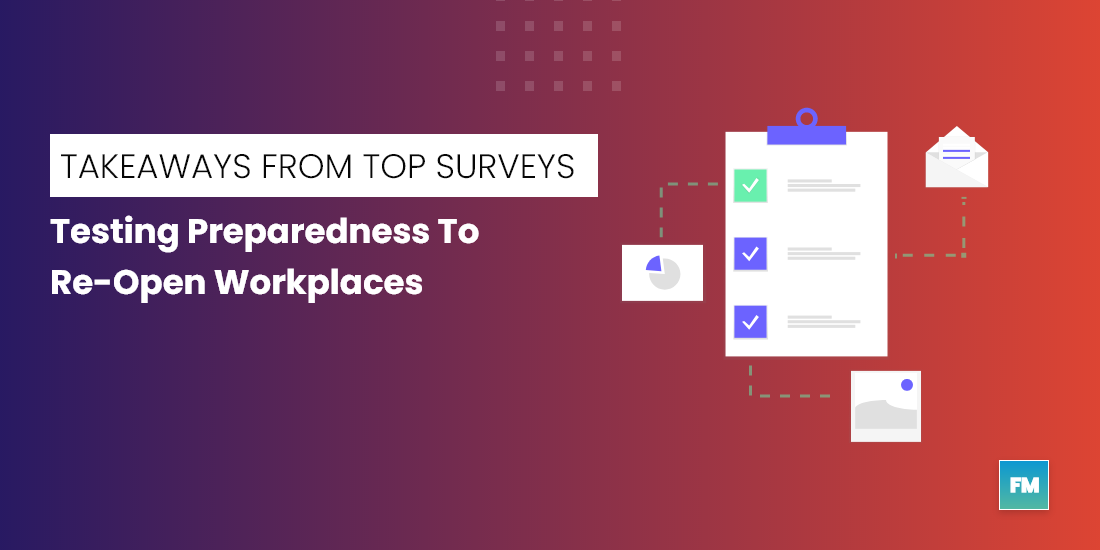Are you familiar with John Driscoll’s Model of Reflection? Also known as the “What, so what, now what” strategy.
I’m sure you’ve heard of it recently. It is a reflective model for understanding problems and finding new solutions. It begins with the incident, leads to gathering information about the consequences, and later on leads to brainstorming ideas and a plan of action.
In light of reaching the halfway point for the year 2021, we thought this might be an appropriate time to introspect the situation with ‘what, so what, now what mindset’ and delve into one of the most frequently discussed yet incomprehensible topics in the CRE and facility management fraternity – How prepared are we and our buildings to reopen? (‘We’ represent all key stakeholders, including tenants, property owners, and facility managers.)
As a part of our research for this blog, we compiled surveys and study reports from leading think tanks, FM firms, and technology providers and analyzed them for distinctive trends and patterns. Some of the honorary mentions are Honeywell’s report – Rethinking buildings post-Covid 19 (June 2021), RICS UK FM Market Survey, Q2 2021, MRI’s Survey of Occupants and Landlords (March 2021)
Although most of the reports differed in their sample sets and survey methodologies, there were some similarities in responses and mindsets toward reopening offices. In this blog, we are highlighting those patterns to provide general consensus among CRE space.
Long-Lasting Impact:
Most of the measures taken as a first response to COVID will remain in place for longer than originally anticipated. Around 71% of respondents (facility managers) in Honeywell’s survey indicated that COVID had made them rethink their O&M practices, and among all the measures taken, air quality upgrades and safety protocols will permanently remain. As FM teams strive to achieve multiple goals, smart building solutions will be seen as a high potential for investment.
In terms of safety measures, Indoor Air quality has become a priority across the globe. 55% of respondents have ranked optimized IAQ as the most important aspect of a healthy building. Intriguingly, that mandate also shows up in investment patterns in technology. As per RICS’s survey, investments in health and well-being have seen the highest growth in the past 12 months besides energy management.
The pace of Digital Transformation:
Most FM teams are drafting their digital strategy, and COVID has given them the much-needed impetus to accelerate their efforts. The use cases that made theoretical sense before the lockdown are now being implemented on a large scale. A change in direction was driven by customer expectations, competition, and the feasibility of operations.
Honeywell’s survey suggests that ninety-four percent of respondents agree that remote facility management has become more important. More than two-thirds of them are interested in investing in smart buildings to drive efficiency and sustainability, as well as technology such as machine learning and artificial intelligence.
There is a high demand for solutions aimed at helping facilities managers remain operational. Research by Resonai forecasts that smart maintenance and repair applications that can help reduce downtime will be adopted at the highest rate (45%) of any new technology.
Expectations Vs Reality:
In spite of the majority of respondents believing in the benefits of new technologies as well as wanting to invest in them, the ground reality is slightly different.
While 93% of respondents agreed that improved air quality is important to occupants and stakeholders, only 37% have air quality management systems in place. The same study found that although 90% of surveyed facility managers think contactless building entry is important, only 35% of them currently implement it.
The DMA group found that 68 percent of facilities management professionals felt confident in knowing how smart technology could save money, time, and improve service delivery quality; however, only 27 percent said their organization’s FM/property teams are unlocking the full potential of smart technology for business process automation.
According to us, the risk appetite is among the reasons they are not following their instinct. It is important to understand that while digital technologies provide lucrative opportunities, the FM teams are working with very small margins of error. They have already digested significant losses due to contract restructuring and these extended lockdowns are only making things difficult for them.
However, this could be an opportunity for technology players to test their applications with low-cost subscription models. They can work under the shared risk principle with the FM team and after successful demonstration charge the full fee.
Customer experience and relation-building:
MRI’s survey revealed that 77% of respondents indicated that contact with tenants and landlords has improved greatly since the pandemic. FM teams can now better handle compliments and suggestions thanks to the switch from email to chat on workplace management applications, which allows turnaround times to be cut dramatically.
Ashok Mathew, senior manager at Ejadah, shared a similar experience during our #CREate talks with CRE changemakers. According to him, covid gave them the opportunity to work closely with developers’ decision-making teams, which helped them understand nuances of the service delivery mechanisms and win six Customer Centricity World Series awards for 2021.
In addition to a change in communication mediums, initiatives like Net Zero have opened up many doors for FM teams to engage with clients’ strategic teams and create new revenue opportunities.
Do you have experience with any of the above 4 trends? Did you learn anything from this experience, and did it assist your team in reassessing the situation and planning a safe reopening? Please share your thoughts with us at [email protected]

Leave a Reply